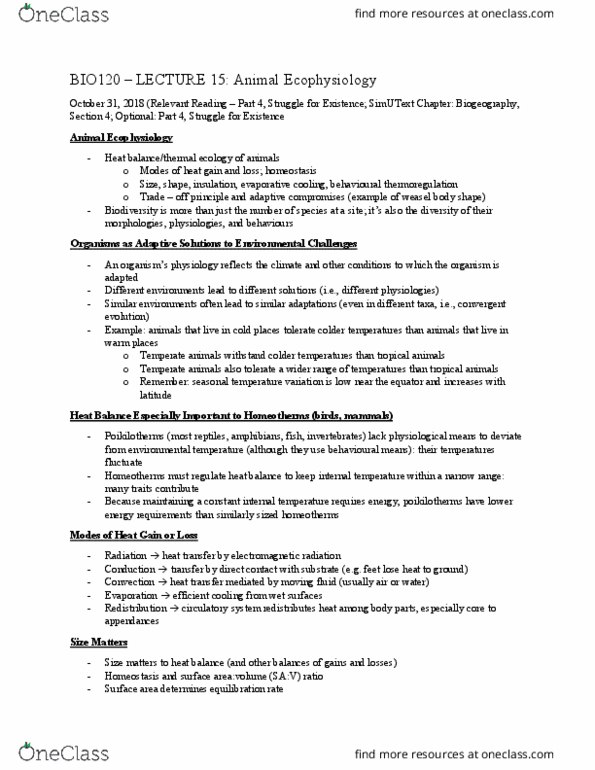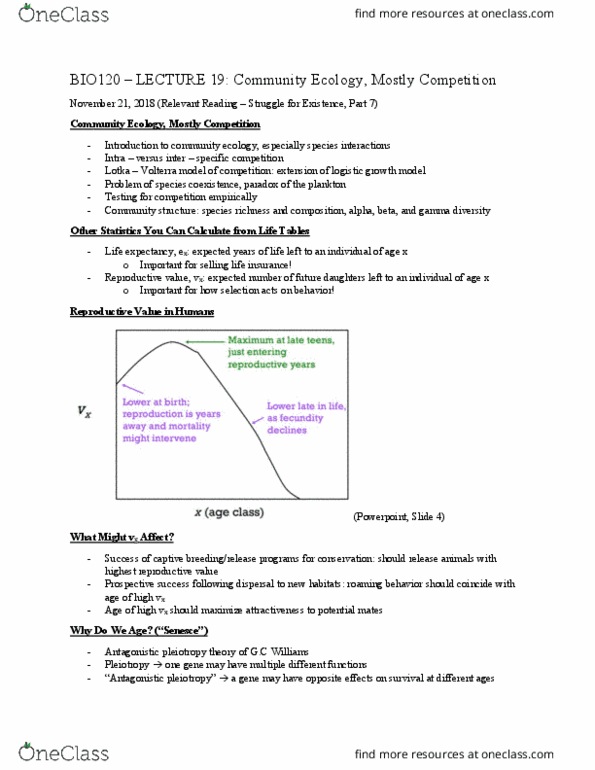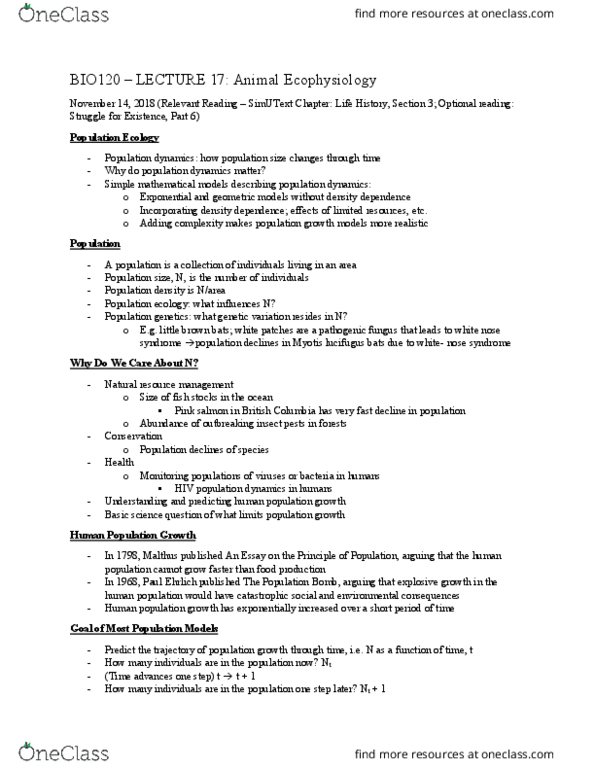BIO120H1 Lecture Notes - Lecture 19: Pleiotropy, Gamma Diversity, Beta Diversity
BIO120H1 verified notes
19/25View all
Do you feel this document is helpful?

BIO120 – LECTURE 19: Community Ecology, Mostly Competition
November 21, 2018 (Relevant Reading – Struggle for Existence, Part 7)
Community Ecology, Mostly Competition
- Introduction to community ecology, especially species interactions
- Intra – versus inter – specific competition
- Lotka – Volterra model of competition: extension of logistic growth model
- Problem of species coexistence, paradox of the plankton
- Testing for competition empirically
- Community structure: species richness and composition, alpha, beta, and gamma diversity
Other Statistics You Can Calculate from Life Tables
- Life expectancy, ex: expected years of life left to an individual of age x
o Important for selling life insurance!
- Reproductive value, vx: expected number of future daughters left to an individual of age x
o Important for how selection acts on behavior!
Reproductive Value in Humans
(Powerpoint, Slide 4)
What Might vx Affect?
- Success of captive breeding/release programs for conservation: should release animals with
highest reproductive value
- Prospective success following dispersal to new habitats: roaming behavior should coincide with
age of high vx
- Age of high vx should maximize attractiveness to potential mates
Why Do We Age? (“Senesce”)
- Antagonistic pleiotropy theory of G.C Williams
- Pleiotropy → one gene may have multiple different functions
- “Antagonistic pleiotropy” → a gene may have opposite effects on survival at different ages
find more resources at oneclass.com
find more resources at oneclass.com

- A gene with positive value in young animals but negative value in old animals will be favoured
by natural selection…
- Reproducing early increases fitness
- Accumulation of such genes causes senescence
- E.g. p53 suppresses tumours in youth, but later destroys stem cells
What Determines Where Species Live?
- Dispersal
- Abiotic Conditions
o Climate
o Nutrients
- Species interactions
o Competition
o Predation
o Mutualism
- Species in a community
Species Interactions
- Interactions between species are often classified by their outcome (+ or -)
- An over – simplification, but a useful starting point
- Competition hurts both species
- Predation benefits predators, but hurts prey (host – parasite and plant – herbivore interactions also
+/- )
- Mutualism helps both species
- (Powerpoint, Slide 8)
Ecology and Evolution of Species Interactions
- Two main foci of study
o Population dynamics and effects on community structure
o Evolutionary dynamics (adaptation, co – evolution)
Competition: Some Terminology
- Intra – specific competition → competition among members of the same species (i.e., among
conspecifics) for resources
- Inter – specific competition → competition among members of different species (i.e., among
heterospecifics) for resources
- Scramble/exploitative competition → depletion of a shared resource
- Contest/interference competition → direct interactions, such as battles over territory
find more resources at oneclass.com
find more resources at oneclass.com

Interference Competition
- E.g. invasive argentine ants fight a harvester ant in California
- Invasive ants often drive down populations of native ants
Exploitative Competition
- Two species do not need to directly interact or even to be active at the same time to compete
- If one consumes a resource, leaving less resource for the other, then they compete
- E.g. squirrel competes with birds for birdfeeders
Inter – Specific Competition for Resources
- Basic model → Lotka – Volterra equations for two species competing for resources
- Simple outgrowth of logistic equation:
o Logistic already has braking term for intra – specific competition
o Just add a second braking term for inter – specific competition
Lotka – Volterra Model of Inter – Specific Competition
1. Start with the logistic model for population growth
; brakes imposed by intraspecific competition for resources
2. Rewrite the logistic model with subscripts to indicate species 1
3. Add a term to show effect of species 2 on species 1
; brakes imposed by inter – specific competition with species 2
4. Write matching equation for species 2
5. Notice that = per – capita effect on i by j = “competition coefficient”
Understanding Competition Coefficients (’s)
- Fixed for a particular pair of species (in theory, anyways)
- converts individuals of species into an equivalent number of individuals of species 1
- E.g. a squirrel can eat a lot more seeds than a sparrow; measures how many sparrows – worth
of seeds a single squirrel eats
Possible Outcomes of Lotka – Volterra Competition
- Equilibrium = N’s no longer changing
- Four possible equilibria
o The two species may stably coexist
o Species 1 may always win (N1 = K1, N2 = 0)
o Species 2 may always win (N2 = K2, N1 = 0)
o Identity of winner may depend on starting N’s
- Outcomes depend on values of K’s and ’s
- Coexistence requires both species to inhibit their own growth more than they inhibit each other’s
- Can expand to consider n species
find more resources at oneclass.com
find more resources at oneclass.com





